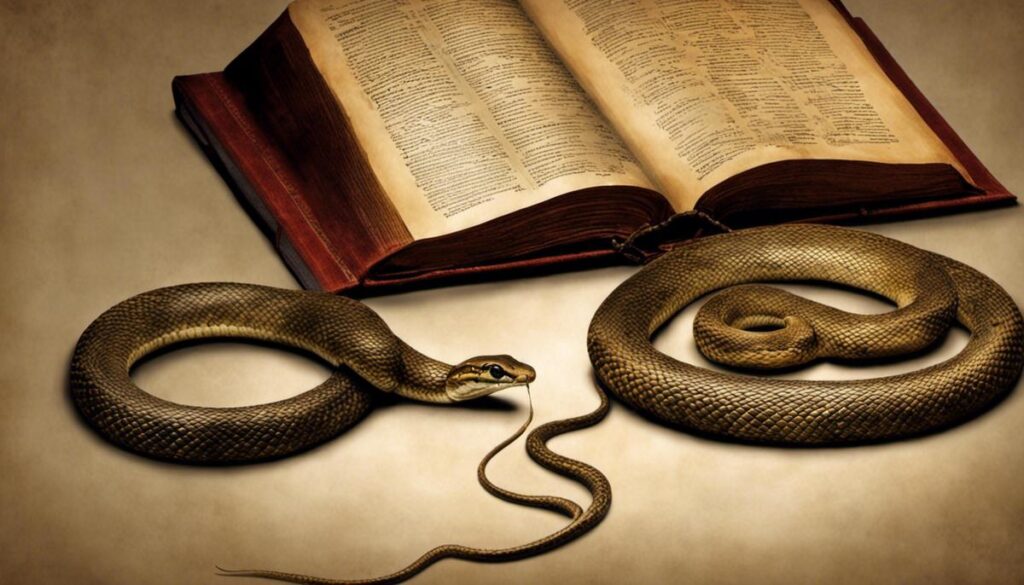In the rich tapestry of biblical texts, the symbolism of creatures, colors, and dreams interweave to form a complex web of interpretation. Nestled within this array of symbols is the intriguing presence of the snake – a creature that has fascinated and mystified biblical scholars for generations. The symbolism intensifies when viewed through color-specific lenses, particularly exploring the portrayal of brown snakes which engenders a more nuanced understanding. This examination is nurtured by our insight into the symbolism and interpretation of dreams within the biblical cosmos, the latter being instrumental in the communication of divine messages. We embark on an enlightening exploration, delving deep into the biblical significance of brown snakes, their symbolic connotations, and their multifaceted manifestation in dreams.
Symbolism of Snakes in Biblical Texts
Monumental in their significance, snakes weave a multifaceted narrative in biblical literature. Towering over the metaphoric landscape, they constitute a pervading symbol distinct in its versatile symbolization, extending from malevolence and deceit to wisdom. Bent on understanding this captivating metaphorical entity, one must delve into the farthest reaches of biblical literature, and unearth the diverse roles undertaken by its serpentine constituents.
Manifesting at the forefront of human sin and fallibility, snakes occupy an indelible position in Genesis. Dignified as the ‘craftiest’ among all beasts by the Bible (Genesis 3:1), the serpent deceives Eve, instigating humanity’s downfall. This seminal act ingrains the snake with an enduring mark of deception, transgression, and malevolence, highlighting the biblical symbolization of snakes as agents of sin.
Transitioning from Genesis, the biblical narrative enriches this symbol in the book of Numbers. The Israelites, punished with a plague of serpents for bemoaning their desert journey (Numbers 21:6), serves as another testament to the snake’s embodiment of punishment and retribution. The instrumental role of the bronze serpent, however, inverts part of the snake symbolism. Erected by Moses, the bronze serpent becomes the vessel of divine healing and redemption (Numbers 21:9), thereby endowing snakes with further symbolic complexity.
Equally intriguing is the undeniable veneer of wisdom linked with serpents. Jesus’s directive in Matthew 10:16 — ‘be wise as serpents and innocent as doves’ — aligns serpent symbolism with prudence and tactfulness. This unexpected association deconstructs the exclusively nefarious symbol of snakes, further emphasizing the creature’s unpredictability and polysemy in biblical literature.
In the apocalyptic literature of Revelation, snakes undertake a shift, morphing into the embodiment of Evil. The ‘great red dragon’ identified as the ‘ancient serpent… who is the devil and Satan’ (Revelation 12:9) amplifies the malevolent aspect of snake symbolism. Elements of deception and sin intensify, enveloping the serpent within the infernal shroud of the anti-divine.
The symbolism of snakes in biblical literature thus emerges as a continually evolving element. Oscillating between sin and wisdom, punishment and redemption, and ultimately embodying malevolence, this chameleonic symbol contributes significantly to the dynamic narrative fabric of the Bible. Operating within these multitudes, it becomes evident that snakes in biblical literature are not merely simplistic figurative devices; instead, they are profoundly nuanced symbols that serve to enrich our understanding of biblical symbolism’s enigmatic complexity.

Specifics of Brown Snakes in Biblical Interpretation
The Interpretational Weight of Snake Colors in Biblical Literature
The symbolism of snakes in biblical literature presents a mesmerizing cache of stylistic and theological expressions. Amidst this collage, appreciating the subtle nuances of their color representations further adds a remarkable layer of depth to interpretations and understanding. Surveying biblical literature, one realizes that specific colors are seldom used to describe snakes. However, by looking at instances of color depictions in tandem with parallel ancient arts and literatures, one could glean interesting insights.
Without explicit color descriptions of biblical snakes, we turn towards ancient Near Eastern and Graeco-Roman arts and texts to unravel potential correlations in color symbolism. For example, a recurrent motif in these works is the representation of chaos, danger, or potency via red colored serpents, possibly alluding to their venomous nature. This corresponds with color symbolism in the Bible where red often symbolizes danger and bloodshed, as seen in the bloody river of Egypt in Exodus.
In contrast, white or pale colored serpents, not directly discussed in the Bible, could denote purity or divinity in other ancient cultures. Concurrently, white-as-purity symbolism is abundant in biblical literature, suggesting a possible link between snake color and its symbolic implications. Therefore, extrapolating from biblical color symbolism, a white serpent could potentially represent divine intervention or mysterious wisdom, similar to the bronze serpent healing the Israelites in Numbers or the wise-as-serpents exhortation in Matthew.
The study of snake color symbolism in biblical literature may also invite an exploration of the metaphorical representation of color in general. For instance, ‘darkness’ and ‘light,’ synonymous with evil and good respectively, are recurring motifs throughout the Bible. Analogously, darker colored snakes could represent evil or ominous forces as in the serpent’s deceptive role in Genesis, while lighter colored snakes could symbolize benevolence or wisdom.
It’s important to underscore that these interpretations are speculative due to the dearth of explicit snake color descriptions in the Bible. Nevertheless, the endeavor to connect biblical color symbolism with snake symbolism offers a stimulating scholarly pursuit. It drives home the point about our relentless search for meaning and our enduring fascination with the symbiotic relationship between nature and scripture, a testament to the integrative power of theological interpretation.
In the end, it appears that the color of a biblical snake, while not explicitly delineated in the text, can bear possible weight in interpretation when assessed through the lens of artistic and literary parallels, color symbolism, and metaphorical value within biblical literature. DISREGARDING the clear biblical context can lead to distorted interpretations, it is essential that any investigation into the color symbolism of snakes remains closely tied to the text, avoiding over-extrapolation and preserving symbolism’s intriguing, subtle complexity.

Interpretations of Dream Symbolism in Biblical Context
Delving into the realm of biblical dream interpretation, one finds an intricate labyrinth of symbolism, imagery, and potent significance. Dreams in the biblical canon exist not only as entities of individual contemplation but often as pivotal moments guiding the narrative trajectory. The place of dreams within biblical literature is critically significant. They serve as platforms of divine revelation, prophetic communication, and vehicles for disseminating deeper spiritual truths.
Joseph, the young, favored son of Jacob, is perhaps one of the most notable figures associated with dreams in the Genesis narrative. His dreams are filled with powerful symbolism—sheaves of wheat and celestial bodies bowing to him—prefiguring his eventual rise to authority. These dreams not only frame Joseph’s personal arc but echo throughout the broader canvas of Israel’s history.
Dreams also serve as divine directives at critical junctures. God’s commandment to Jacob in a dream marks a pivotal turning point in the patriarch’s life. Similarly, Joseph, husband of Mary, is guided through dreams in the course of Jesus’ early life, each dream functioning as a divine signpost guiding him in nurturing and protecting the Son of God.
A notable intersection of dreams and prophecy is embodied in the figure of Daniel, whose interpretation of Hallucinatory and surreal dreams of world-empires function as profound cosmic signifiers prophesying future events.
The interconnectedness of dreams within a broader frame of biblical interpretation can be understood in terms of their symbolic, prophetic, and revelatory functions. These transcend mere psychoanalytical aspects and carry profound theological implications.
By examining dreams from a linguistic and symbolic perspective, one finds recurring motifs in biblical literature. Repeated symbols, such as towers, animals, and even celestial bodies, form the symbolic language of dreams revealing consistent archetypal patterns that speak volumes about the human condition vis-a-vis the divine.
The prophetic nature of dreams, their use for divine revelation, their occurrence at pivotal turning points, all underscore the need for a contextual interpretation that is sensitive to the cultural, political, and social milieu of the biblical era. This ensures a comprehensive understanding of these symbolic narratives and their enriching theological implications.
Recognizing the role of dreams in biblical literature opens new vistas in the realm of ancient Near Eastern literature, social history, philosophy, and religion, inviting a fascinating and enriching dialogue between faith, scripture, and the human person’s eternal quest for understanding. In the silent language of dreams, the biblical text whispers of God’s mysterious ways, as they unfold in the theater of human history.

Brown Snakes in Dreams: A Comprehensive Analysis
–A Move to Brown Snakes in Biblical Dream Interpretations
Pivoting from the biblical narrative and symbolism encompassed by the serpent, we venture to the aftermath of biblical history, migrating into the realm of contemporary dream interpretation from a biblical perspective. Particularly intriguing is the imagery of a brown snake, a distinct interpretation spurred from the common lack of explicit color association in biblical literature, yet deeply rooted in the broad sketchwork of the ancient text.
In the realm of biblical dream interpretation, scholars meticulously scrutinize dream symbols as tools for divine communication. A dream involving a brown snake, thus, elicits a possible narrative uncovered through biblical symbolism and contemporary psycho-spiritual theory. The color brown, notably absent in biblical texts, yet provides a rich interpretative landscape influenced by cultural, psychological, and theological factors.
The color brown, often associated with earth and soil in cultural vernacular, symbolizes the principles of groundedness, stability, and simplicity. Alas, in biblical literature, the snake serves a dual function as a symbol of both treachery and wisdom. Thus, a brown snake may integrate these seemingly paradoxical attributions. Consequently, such a dream can imply a spiritual message urging the dreamer to ground wisdom in their life or to be wary of a seemingly grounded person or situation which may prove deceptive.
Drawing from biblical narratives possessing intricate layers of symbolism and theological connections, there’s the understanding that brown may bear associations with practicality, material nature, and utilitarianism. Therefore, dreaming about brown snakes may represent earthly wisdom or disillusionment with material pursuits.
It becomes evident that biblical dream interpretation invokes contextual wisdom integrating academic disciplines and drawing links between biblical text and modern dream occurrences. It creates a contemporary contemplative approach, steering clear of rigid dogmatism while establishing seeds of thought and introspection.
While each dream interpretation script can only provide a hypothetical conjecture, especially considering the lack of explicit biblical reference to the color brown, the indelible connection between dreams and the divine guidance in biblical literature implies practical discernment and spiritual intuition in the interpretation process. By embracing a prudent approach, the essential essence of biblical wisdom is invoked, providing poignant insights into understanding modern dreams, such as those about brown snakes.
The gravity of the interpretative task is considerable; correlating biblical symbology with dreams can serve as testament to a profound weave between one’s subconscious and the spiritual realm. Dreams don’t stand as mere background noise of the sleeping mind but rather as significant, potential conduits of divine messages and self-knowing.
In conclusion, dreaming of brown snakes may, potentially, be a harbinger of wisdom and treachery, an indicator of grounding and deceit, and a reflection of one’s relation to materialism. Yet, the subjective nature of dreams insists on an individualized approach to interpretations, peppered with guided yet flexible symbolism. This complex tapestry weaves together the threads of biblical scholarship, modern psychology, spiritual insights, and an individual’s unique experience — creating a rich tableau for biblical interpretation in the 21st century.

Grasping the layers of symbolism represented by brown snakes in dreams within the biblical context necessitates a measured and informed analysis, one that considers a multiplicity of elements: the biblical significance of snakes, the subtle undertones that colour imparts, and the depth of dream interpretation within the Bible. This multifaceted approach imbues us with a deeper comprehension of the interconnectedness of these symbols, encouraging us to continually question, explore, and decipher the wisdom encoded within such symbols. As we delve into the realm of dream symbology with an open mind, we find that these interpretations offer more than just perception; they potentially provide a unique lens through which we can examine our life, our faith, and our understanding of spiritual symbolism.







